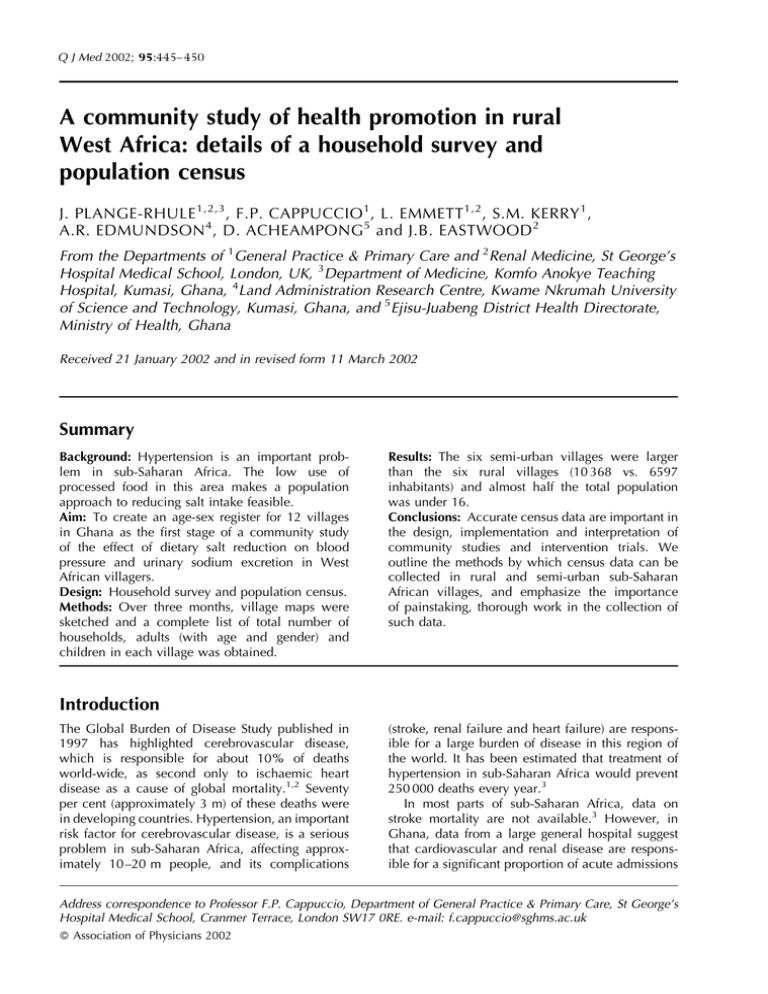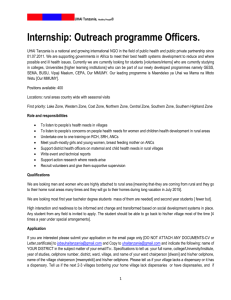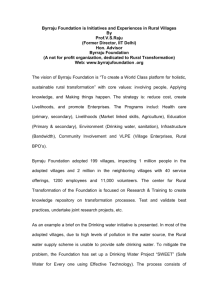A community study of health promotion in rural population census
advertisement

Q J Med 2002; 95:445– 450 A community study of health promotion in rural West Africa: details of a household survey and population census J. PLANGE-RHULE 1,2,3 , F.P. CAPPUCCIO 1 , L. EMMETT 1,2 , S.M. KERRY 1 , A.R. EDMUNDSON 4 , D. ACHEAMPONG 5 and J.B. EASTWOOD 2 From the Departments of 1General Practice & Primary Care and 2Renal Medicine, St George’s Hospital Medical School, London, UK, 3Department of Medicine, Komfo Anokye Teaching Hospital, Kumasi, Ghana, 4Land Administration Research Centre, Kwame Nkrumah University of Science and Technology, Kumasi, Ghana, and 5Ejisu-Juabeng District Health Directorate, Ministry of Health, Ghana Received 21 January 2002 and in revised form 11 March 2002 Summary Background: Hypertension is an important problem in sub-Saharan Africa. The low use of processed food in this area makes a population approach to reducing salt intake feasible. Aim: To create an age-sex register for 12 villages in Ghana as the first stage of a community study of the effect of dietary salt reduction on blood pressure and urinary sodium excretion in West African villagers. Design: Household survey and population census. Methods: Over three months, village maps were sketched and a complete list of total number of households, adults (with age and gender) and children in each village was obtained. Results: The six semi-urban villages were larger than the six rural villages (10 368 vs. 6597 inhabitants) and almost half the total population was under 16. Conclusions: Accurate census data are important in the design, implementation and interpretation of community studies and intervention trials. We outline the methods by which census data can be collected in rural and semi-urban sub-Saharan African villages, and emphasize the importance of painstaking, thorough work in the collection of such data. Introduction The Global Burden of Disease Study published in 1997 has highlighted cerebrovascular disease, which is responsible for about 10% of deaths world-wide, as second only to ischaemic heart disease as a cause of global mortality.1,2 Seventy per cent (approximately 3 m) of these deaths were in developing countries. Hypertension, an important risk factor for cerebrovascular disease, is a serious problem in sub-Saharan Africa, affecting approximately 10 –20 m people, and its complications (stroke, renal failure and heart failure) are responsible for a large burden of disease in this region of the world. It has been estimated that treatment of hypertension in sub-Saharan Africa would prevent 250 000 deaths every year.3 In most parts of sub-Saharan Africa, data on stroke mortality are not available.3 However, in Ghana, data from a large general hospital suggest that cardiovascular and renal disease are responsible for a significant proportion of acute admissions Address correspondence to Professor F.P. Cappuccio, Department of General Practice & Primary Care, St George’s Hospital Medical School, Cranmer Terrace, London SW17 0RE. e-mail: f.cappuccio@sghms.ac.uk ß Association of Physicians 2002 446 J. Plange-Rhule et al. to general medical wards, and for a quarter of the deaths.4 Further, hypertensives seen in the local hypertension clinic have a high prevalence of renal impairment.4 Blood pressure can be lowered by reducing salt intake5 and Black people of African origin are more susceptible to this effect than are White people.5,6 There is no threshold effect: the lower an individual’s salt intake, the lower their blood pressure, even within the normal range of blood pressure.7–9 In much of sub-Saharan Africa, processed food is used relatively sparingly,5 compared with developed countries, and most of the salt ingested has been added to food by the consumer. In these countries, a population approach to salt reduction is thus more feasible10 than in developed countries where the majority of salt consumed is concealed within processed food. The population approach is particularly relevant in the developing countries of sub-Saharan Africa, where effective health care provision for chronic diseases, and for the detection, management and control of hypertension, is haphazard.3 On this basis, we devised a community cluster randomized controlled trial for a group of villages in West Africa. Before initiating the study proper, however, we carried out a comprehensive household survey and population census to create an agesex register of the 12 villages involved. This report outlines the strategy used, and details the problems encountered. Setting Figure 1. Map of the area around Kumasi. Circles indicate rural villages and closed circles semi urban villages. 1, Pemenase; 2, Edwenase; 3, Domeabra; 4, Tikrom; 5, Ofoase; 6, Atia; 7, Dumakwai; 8, Appeadu; 9, Duase; 10, Apatrapa; 11, Feyiase; 12, Nwamase. Our survey was carried out in the Ashanti region of Ghana. Ghana covers an area of 238 540 km2 with a total population of 19 678 000 (density 81/km2). It borders Côte d’Ivoire to the west, Burkina Faso to the north, Togo to the east and the Gulf of Guinea to the south. According to WHO figures for 1999, the Disability Adjusted Life Expectancy (DALE) is 45.5 years (45.0 for males, 46.0 for females).11 English is the official language, the main indigenous languages being Twi, Ga, Fanti, Ewe and Hausa. The south of the country has been influenced by Christianity and Western culture, while the north has an Islamic tradition, although many Ghanaians maintain their tribal beliefs and customs. The Ashanti region extends across the Kwahu Plateau, covering an area of 25 100 km2 of tropical rain forest terrain. It is home to about 2 m people and its capital, Kumasi, about 250 km north-west of Accra, is the second largest city in Ghana. The region produces most of the country’s cocoa, minerals and timber. The survey encompassed 12 communities in the Ejisu-Juabeng and Kumasi Districts (Figure 1), composed predominantly of the Akan ethnic group, whose dialect is Asante Twi. The villages chosen for the study communicate little with each other, as roads other than those shown in Figure 1 are unpaved, and transport is not generally available. Six villages were considered to be rural, as they generally lack electricity and piped water, have a small population, and are some distance from Kumasi. The villagers use common sources of water from bore-holes or stand pipes or from water courses, and use communal sanitary facilities. The main occupation is farming. The remaining six villages we designated semi-urban. They are mostly closer to Kumasi and usually have electricity, Methods A census in rural West Africa although not all have piped water, and may have communal sanitary facilities. Although the main activity is farming, trading is a frequent occupation. The area is served by the Komfo Anokye Teaching Hospital, the only tertiary referral hospital in the region. In 1995, the hospital set up a blood pressure clinic which now sees around 500 new patients a year. Census techniques A team of fieldworkers, fluent in both English and Twi, undertook population censuses in the 12 villages between January and March 2001. The first step was to assign an address to each household. The fieldworkers painted white numbers on the doorways of each house and with the aid of these numbers created a map of each village. A household was defined as one or more families living within a single building which might contain several rooms. In some instances the rooms open out into a central courtyard, which may serve as a communal cooking area. To create a village map, first the main road of each village was sketched, then a fieldworker would walk up each side of the road and each would draw the houses on their side. Every now and again the fieldworkers would note a landmark on the opposite side of the road so that the two sides could be matched up. Odd numbered households were on one side of the road and even numbered ones on the other. The maps show the size of the houses as well as the house numbers. Unoccupied properties were also noted and half-built dwellings indicated by dashed lines. The finished maps, therefore, show all the houses as well as important landmarks such as schools, markets, churches and mosques, water sources and sanitary facilities (Figure 2). A complete list of the total number of households, adults and children in each village was obtained. For each house, the fieldworkers recorded the number of under-16s (males and females separately) and the names of all the adults (016 years) with their age and gender. Where necessary, fieldworkers visited a house up to 3 times to try to obtain as complete information as possible. The name of the fieldworker was also recorded so that if any queries arose when the co-ordinating centre in London was processing the data, the particular fieldworker who had originally visited that household could be contacted. All census information was entered into an Access database and checked for accuracy. The age of the villagers was not always accurate, as many individuals did not have birth certificates or other form of identification giving date of birth. 447 To improve accuracy, the fieldworkers used a guide sheet for important dates and events, such as the Yaa Asantewaa War of 1900, the earthquake of 1939, the ‘looting time’ of 1948, Independence in 1957, the visit of Queen Elizabeth II to Ghana in 1961, the overthrow of Kwame Nkrumah in 1966 and the more contemporary political events up to Kufour’s electoral victory in 2000. In London, to ensure accuracy the census and household information was cross-checked carefully against the information gathered when compiling the list of individual adults. Where there were discrepancies, clarification was sought from the collaborators in Kumasi. Sometimes, two fieldworkers appeared to have visited the same household and had assigned a different house number, and in some instances there appeared to be different residents. Some houses, however, had more than one entrance and although originally just one number had been painted on the doorway, this was later changed to, for example, 060A and 060B. Sometimes, the fieldworkers had to go back to the villages to resolve uncertainties. Four individuals on the list of adults were found to be under 16, so their names were removed from the adult list and added to the numbers of children on the household summary list. The study protocol was approved by the Committee on Human Research Publication and Ethics of the School of Medical Sciences, Kwame Nkrumah University of Science and Technology, Kumasi and endorsed by the Local Ethics Committee in London. As the study got under way, meetings were held with the Chief and the Council of Elders in each village to explain the study and to seek local consent. Statistical methods Information on ages was collected only on those individuals aged 16 or over. To calculate valid 10-year age categories for the under 20s in the population pyramids, we assumed an equal distribution of individuals under 16. The 0 –9 age group therefore comprised 10/16 of those under 16. The 10 –19 group consisted of 6/10 of the under16s plus the 16 –19 year group. This assumption of equal numbers in each age group under 16 is supported by US Census Bureau data. Results The total population of the six semi-urban villages was 57% higher than that of the six rural villages (10 368 inhabitants vs. 6597), and the proportion of children was less (42.9% vs. 49.7%) (Table 1). In J. Plange-Rhule et al. 448 Figure 2. Example of village map drawn at the time of the population census. Table 1 Census data in all 12 villages Village type Rural Semi-urban Households 750 710 Adults* Children Adults of unknown age Per household M F M F M F Adults Children 1359 2654 1957 3264 1660 2252 1621 2198 71 17 62 14 4.4 8.3 4.4 6.3 Total 6597 10 368 *Including those of unknown age. one household in a rural village there was a very large number of under 16s, 62 males and 35 females; this, however, was an isolated case. In the rural villages the age of 133 adults (4%) could not be ascertained; in the semi-urban villages the proportion was much lower at 31 adults (0.31%). Overall the adults with unknown age accounted for just 1% of the total population. The median age of the 12 communities was 18 (16 for males, 20 for females). Table 2 shows details of individual villages. The average village population was 1414 (range 562–1966). The percentage of adult males (016 years) was less than the percentage of adult females in all 12 communities, the widest gender difference being in village 3 (males 36.8% of total adults). The proportion of adult males in the rural villages overall was lower than in the semi-urban villages. The age-gender distribution of the population in rural and semi-urban villages is shown in Figure 3. The lower steps illustrate the large numbers of children as well as the lack of 20 –29 year olds, especially males, in the rural villages. A census in rural West Africa Table 2 449 Census data by village Village Households Adults Children Total % Male Average age (M) Average age (F) Total % Male Total population Rural 1 2 3 5 6 7 All rural 163 74 119 91 176 127 750 611 296 753 337 766 553 3316 41.9 40.9 36.8 41.5 41.6 44.5 41.2 38.4 39.9 35.1 42.2 39.0 35.1 37.8 37.2 42.5 38.2 41.4 38.9 35.6 38.5 558 266 606 374 884 593 3281 53.6 52.3 48.8 47.1 51.1 50.3 52.5 1169 562 1359 711 1650 1146 6597 Semi-urban 4 8 9 10 11 12 All semi-urban 162 91 79 127 116 135 710 1042 654 1144 1089 906 1083 5918 39.0 46.8 43.6 46.4 46.9 47.4 45.0 35.1 32.6 34.6 31.5 33.5 32.4 33.2 40.0 36.9 37.4 34.1 35.0 34.4 36.4 924 551 819 706 653 797 4450 50.5 49.0 49.3 51.8 47.6 54.5 50.5 1966 1205 1963 1795 1559 1880 10 368 Figure 3. Population pyramids obtained from the population census (see text for details). Discussion Demographic data in developing countries may be unreliable, out of date or even completely lacking. In projects involving whole communities, it is therefore usual to collect one’s own demographic data to provide up-to-date sampling frames.12 Our direct mapping of the houses and door-todoor collection of information from the inhabitants of the houses has produced demographic information similar to that for Ghana as a whole and to that observed in other developing countries. We believe that the maps are as accurate as we could have achieved. In our census, we believe that we now have a solid base of reliable information upon which to build our intervention study. We were helped by good communication between the local branch of the Ministry of Health and the Chiefs and Elders of the villages, as well as the village health workers. Many of the individuals did not have birth certification, so their recorded age cannot be as accurate as we would have liked. However, the guide sheet of 21 memorable dates undoubtedly improved the accuracy of the information collected. In Ghana, birth certificates are issued by the District Registrar of births and deaths. There is a high prevalence of non-registrations and late registrations, and many only register when other documentation, e.g. a passport, is required. This is partly because the certificate has to be signed as valid by the Registrar in Accra (approx. 250 km away). Therefore, the age pyramids for adults cannot be totally accurate. As regards under-16s, we decided not to ascertain individuals’ ages, as the target group for our intervention study was to be adults. The reason for the lack of 20 –29 year olds in the rural villages is not entirely clear. The young men may have left their villages temporarily to go to work on their farms (i.e. the census would be 450 J. Plange-Rhule et al. incomplete) but more probably the young men have left to seek work in the cities (i.e. their migration is more permanent). In the latter case, the census would be an accurate reflection of the rural populations. This lack of 20 –29 year olds should not affect the validity of our planned intervention study, as we are studying 40 –75 year olds. This community approach has been used by others in the collection of data, such as death certification, in these settings. Verbal autopsies, whereby local health workers try to establish cause of death by questioning bereaved relatives as to the symptoms and signs of the individual prior to death, is a good example.13,14 The collection of local burden of disease data is critical for priority setting in health policy and research, and accurate census data is an important component. The extrapolation of, for example, Global Burden of Disease data may not be satisfactory, as estimates are not sufficient to provide a characterization of the burden of disease in sub-Saharan Africa that is detailed and accurate enough to provide a basis for local health policy.15 In summary, this short account highlights the methods by which census data can be collected in rural and semi-urban sub-Saharan African villages, and emphasizes the importance of painstaking thorough work in the collection of such data. Acknowledgements We thank the many enthusiastic workers in Ghana who have contributed to this small study and will continue to contribute to the 3-year project. They are Dr S. Antwi, Dr F. Micah, Dr R. Martin-Peprah and Dr R. Phillips; the Nurses A. Asare Bediako, H. Boatemaa, S. Manu, O. Otoo Mensah, V. Osei, J. Prempeh and J. Yalleh; the Community Health Visitors C. Frimpong and E. Quaicoo; the Fieldworkers K. Adjei, C. Ankisiba, S. Boate and D. Dwamena. We also thank A. Gyebi for help with the map drawing and M. Adi-Darko for helping develop the educational material. We would also like to thank the Chiefs and Elders of the 12 villages for their help. The study was funded by The Wellcome Trust (Project Grant 060415/Z/00/Z). Early work in preparation for the main study was made possible by a grant from the Association of Physicians of Great Britain and Ireland. References 1. Murray CJL, Lopez AD. Global mortality, disability, and the contribution of risk factors: Global Burden of Disease Study. Lancet 1997; 349:1436 – 42. 2. Murray CJL, Lopez AD. Mortality by cause for eight regions of the world: Global Burden of Disease Study. Lancet 1997; 349:1269–76. 3. Cooper RS, Rotimi C, Kaufman JS, Muna WFT, Mensah G. Hypertension treatment and control in sub-Saharan Africa: the epidemiological basis for policy. Br Med J 1998; 312:614 –17. 4. Plange-Rhule J, Phillips R, Acheampong JW, Saggar-Malik AK, Cappuccio FP, Eastwood JB. Hypertension and renal failure in Kumasi, Ghana. J Hum Hypert 1999; 13:37– 40. 5. Cappuccio FP. Salt and blood pressure. Issues for populationbased prevention and public health strategies. Public Health Medicine 2000; 2:57– 61. 6. Cooper R, Rotimi C. Hypertension in blacks. Am J Hypertens 1997; 7:804 –12. 7. MacGregor GA, Markandu ND, Sagnella GA, Singer DRJ, Cappuccio FP. Double-blind study of three sodium intakes and long-term effects of sodium restriction in essential hypertension. Lancet 1989; ii:1244 –7. 8. Sacks FM, Svetkey LP, Vollmer WM, et al. Effects on blood pressure of reduced dietary sodium and the Dietary Approaches to Stop Hypertension (DASH) diet. N Engl J Med 2001; 344:3–10. 9. Cappuccio FP, Markandu ND, Carney C, Sagnella GA, MacGregor GA. Double-blind randomised trial of modest salt restriction in older people. Lancet 1997; 350:850 – 4. 10. Cappuccio FP, Plange-Rhule J, Phillips RO, Eastwood JB. Prevention of hypertension and stroke in Africa. Lancet 2000; 356:677– 8. 11. Mathers CD, Sadan R, Salomon JA, Murray CJL, Lopez AD. Healthy life expectancy in 191 countries. Lancet 2001; 357:1685–91. 12. Kahn K, Tollman SM, Garenne M, Gear JSS. Who dies from what? Determining cause of death in South Africa’s rural north-east. Trop Med Int Health 1999; 4:433– 41. 13. Chandramohan D, Maude GH, Rodrigues LC, Hayes RJ. Verbal autopsies for adult deaths: issues in their development and validation. Int J Epidemiol 1994; 23:213–22. 14. Chandramohan D, Maude GH, Rodrigues LC, Hayes RJ. Verbal autopsies for adult deaths: their development and validity in a multicentre study. Trop Med Int Health 1998; 3:436 – 46. 15. Würthwein R, Gbangou A, Sauerborn R, Schmidt CM. Measuring the local burden of disease. A study of years lost in sub-Saharan Africa. Int J Epidemiol 2001; 30:501– 8.







